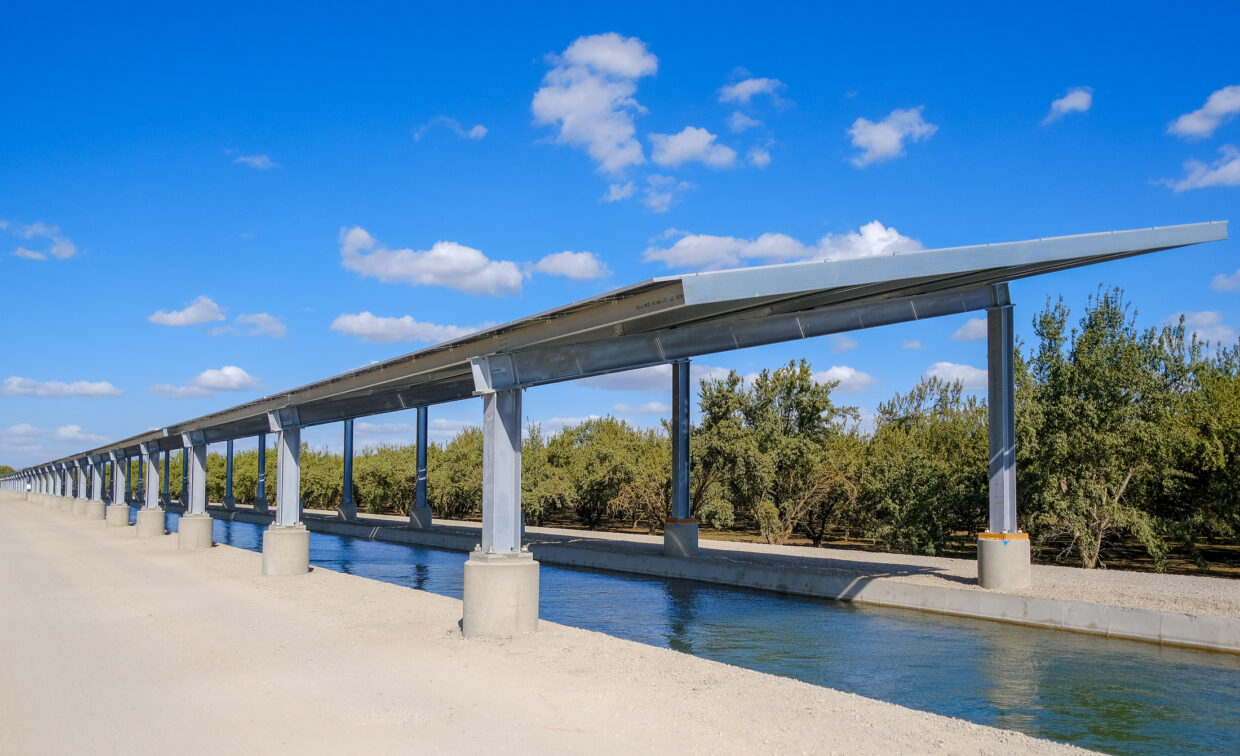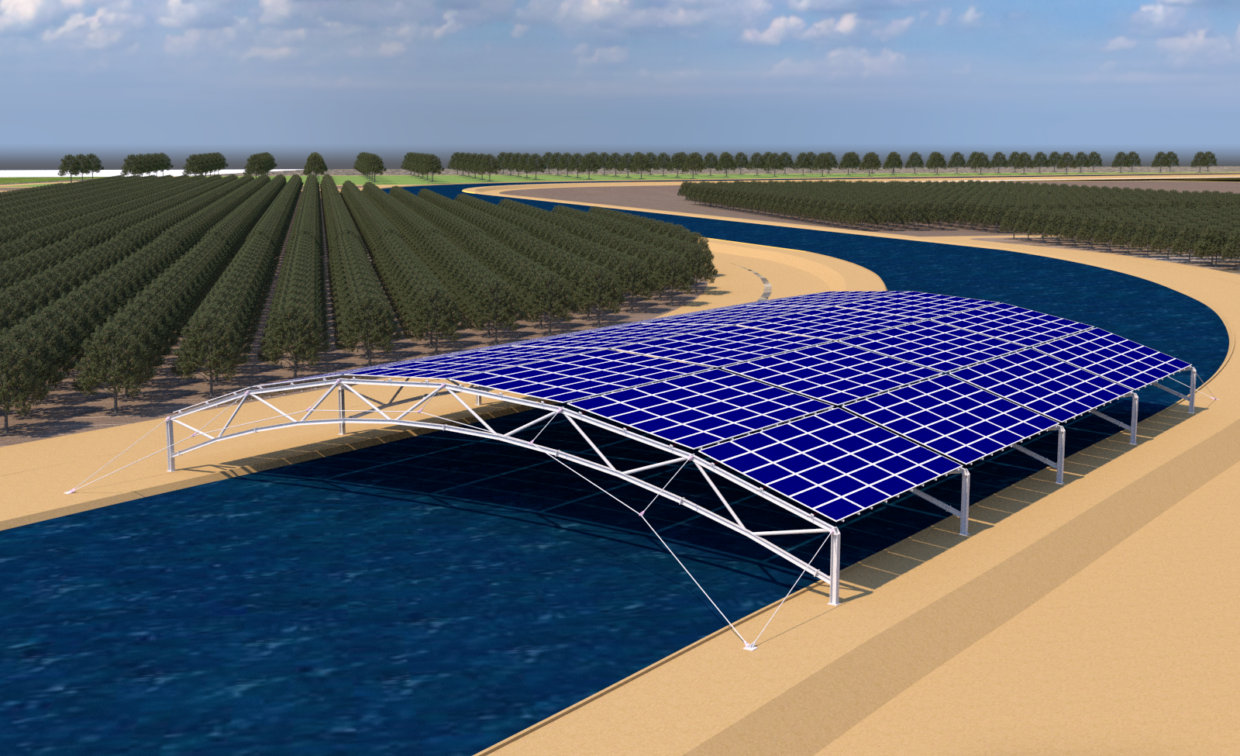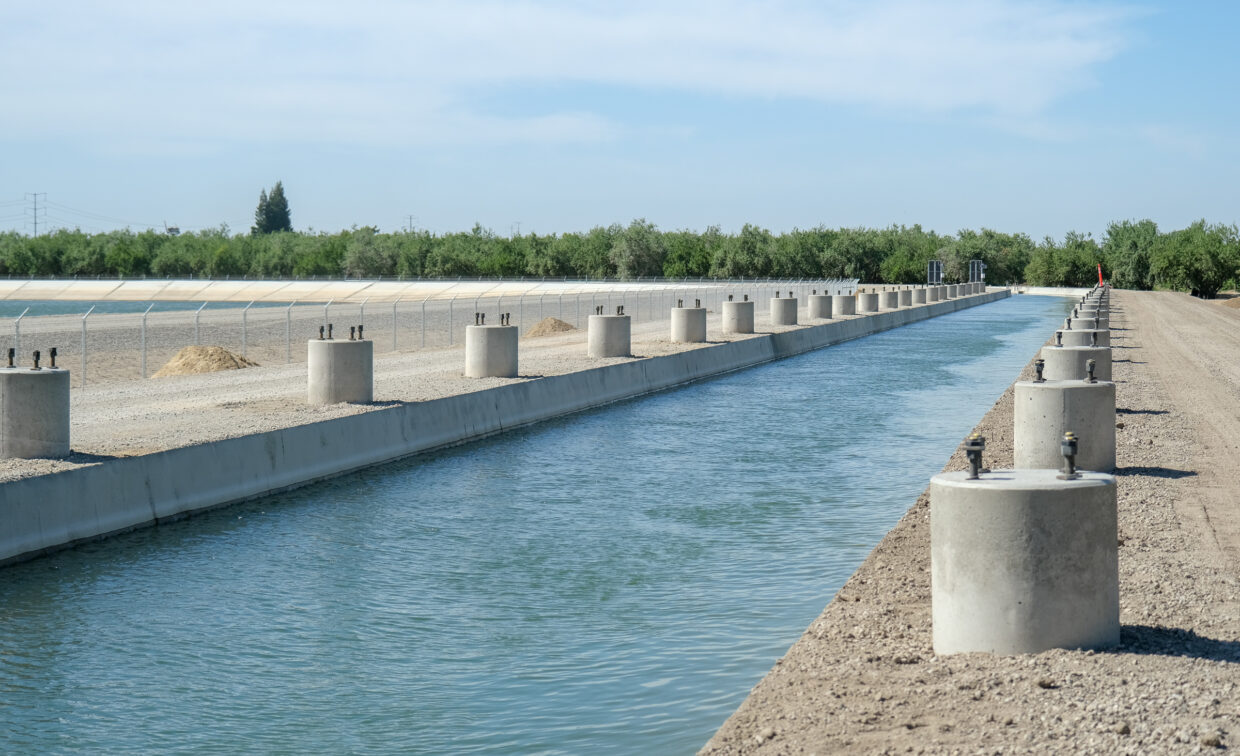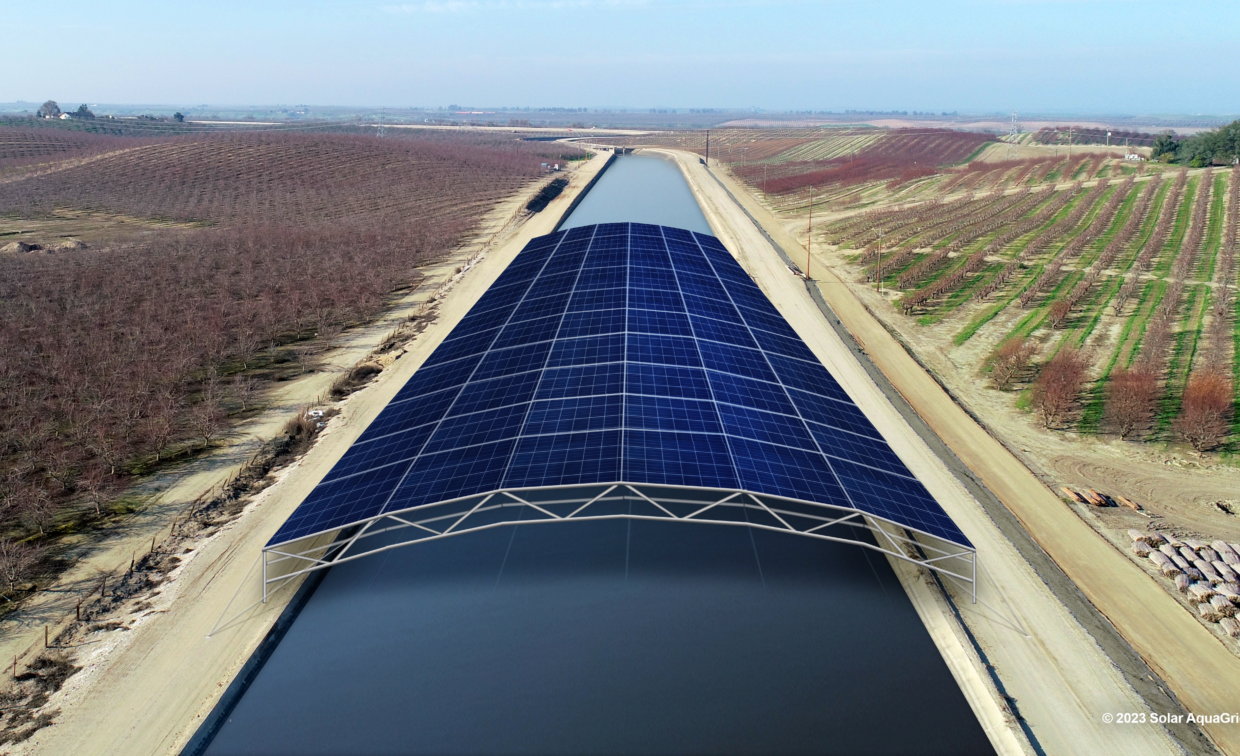Project Nexus
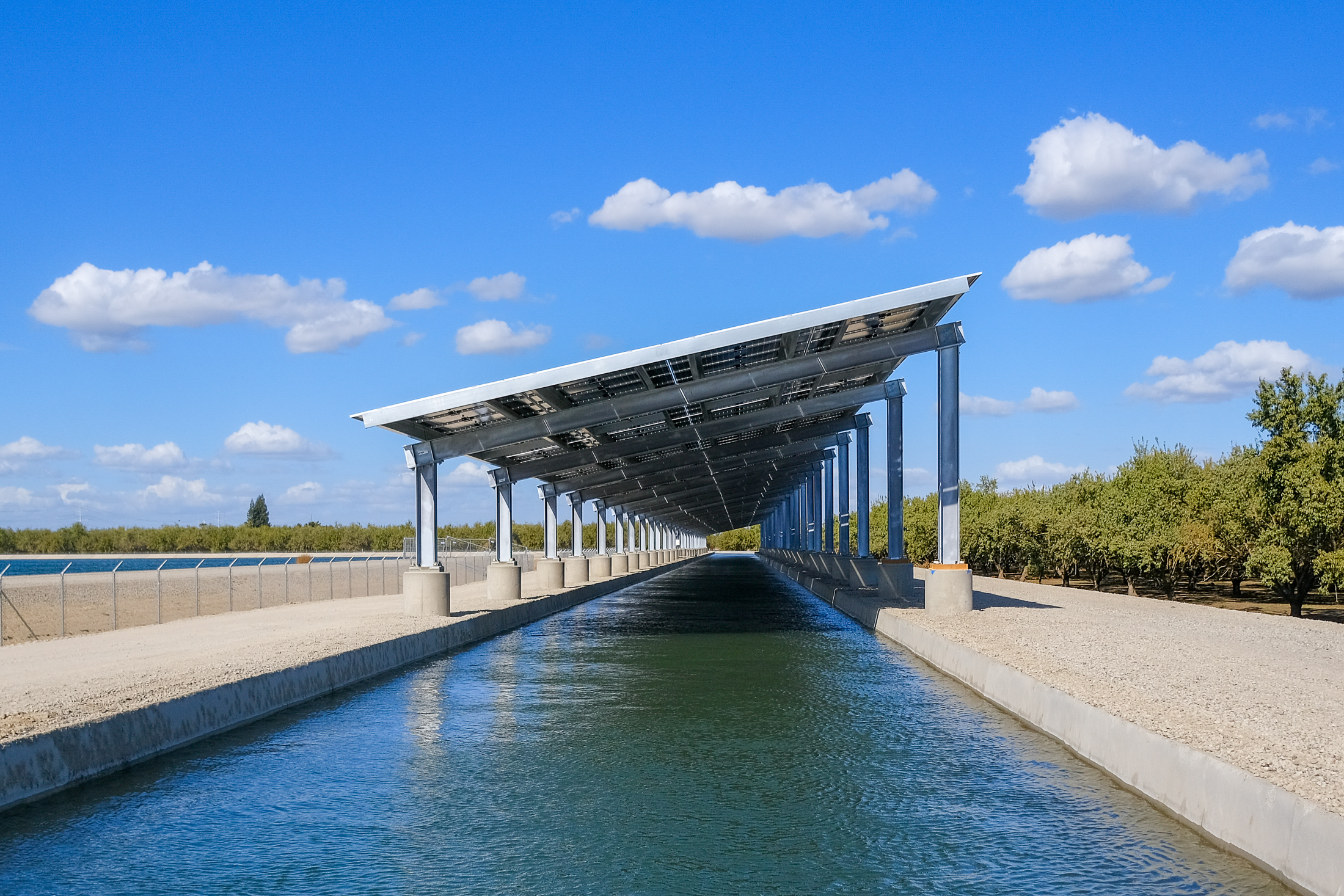

What is Project Nexus?
Project Nexus includes the installation of solar panel canopies over various sections of Turlock Irrigation District’s (TID) irrigation canals. Project Nexus serves as a Proof of Concept to pilot and further study solar over canal design, deployment, and co-benefits on behalf of the State of California using TID infrastructure and electrical grid access.
The Project at both locations is expected to be completed and commissioned by 2025.
Project Nexus Update
Construction is underway at the 20-foot-wide canal project location, with the first solar panels now mounted over TID canals.
Work on the 110-foot-wide canal will commence after TID’s irrigation season ends in November. University of California, Merced has positioned research equipment at both sites to collect baseline data.
The project at both locations is expected to be completed and commissioned by 2025.
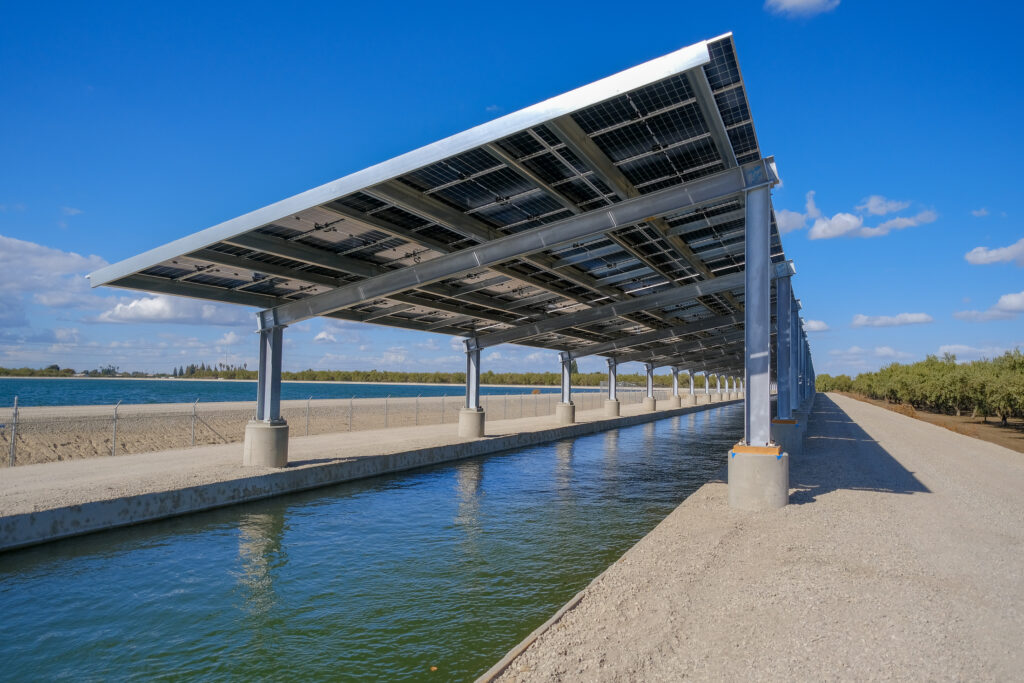
Project Nexus Fast Facts
- First in the Nation project
- TID was the first publicly-owned irrigation district in CA
- Collaboration among public, private, and academic sectors
- Funded by the State of California
- Two project sites along various sections of TID’s canal system
- Providing over 1 MW of renewable power generation
- Energy storage to be incorporated
Who are the Project Nexus Partners?
The first test deployment of solar panels over open canals in the nation is being developed as a public-private-academic collaboration, including:
- Turlock Irrigation District – The first irrigation district in California, TID is uniquely suited to pilot this project as both an irrigation district with 250 miles of canals and a retail electricity provider to homes, businesses and farms in the central valley.
- CA Department of Water Resources – DWR is committed to exploring all efforts meant to advance integration of renewable energy to provide clean energy to California. The Department is providing funding from the state general fund and technical assistance to TID.
- Solar AquaGrid – Bay Area development firm Solar AquaGrid serves as program manager for Project Nexus. Solar AquaGrid originated the pilot project after first commissioning the UC Merced Study in 2015, and is facilitating collaboration among TID and the various parties to bring Project Nexus to fruition.
- UC Merced – Located only a few miles from TID, UC Merced researchers have been contracted to provide ongoing support, research and analysis of the project for the state and public.
Project Nexus Goals
- Assess the feasibility of installing solar panels over canals
- Determine the reduction in water evaporation
- Evaluate the improvements to water quality
- Provide renewable power generation
- Demonstrate scalability
UC Merced Study
The 2021 study showed that covering all of the approximately 4,000 miles of public water delivery system infrastructure in California with solar panels can result in significant, water, energy and cost savings for the state. The study illustrates a savings of 63 billion gallons of water annually (enough to irrigate 50,000 acres of farmland or meet the residential water needs of more than 2 million people).
Based on data from the published study, the researchers estimated that covering the state’s canals with solar would generate 13 gigawatts of power, which is more than half the projected new solar capacity needed by 2030 to meet the state’s decarbonization goals. As such, Project Nexus is a way to test these conceptual projections at a much smaller scale.
Frequently Asked Questions
What is Project Nexus?
Project Nexus culminates with the installation of solar panel canopies over various sections of Turlock Irrigation District’s irrigation canals. Project Nexus will serve as a Proof of Concept to pilot and further study solar over canal design, deployment, and co-benefits on behalf of the State of California using TID land and grid access. The Project is a partnership between TID, the California’s Department of Water Resources, the University of California, Merced, and development firm Solar AquaGrid. Project Nexus will serve as a Proof of Concept to pilot and further study solar-over-canal design, deployment, and co-benefits on behalf of the State of California using TID land and energy grid access.
The primary goals of Project Nexus include:
- Demonstrate proof of concept of narrow and wide-span canal coverage of solar panels
- Increase renewable power generation
- Reduce water evaporation in canals
- Experience water quality improvements
- Reduce vegetative growth in the canals
- Investigate energy storage via use cases
- Investigate integration between renewable power generation and energy storage
How did Project Nexus get its name?
The pilot project is called Project Nexus as a nod to the water-energy nexus paradigm gaining attention among public utilities. Utilities are increasingly recognizing the symbiotic relationship between water management and energy management, and are finding ways to design projects and actions that benefit the management of both resources beyond what has been done historically.
Project Nexus goes beyond recognizing the linkage that water is used for energy production and energy is used for water treatment and conveyance. With Project Nexus, existing water conveyance infrastructure will serve as the foundation for solar canopies to produce renewable energy. The water in the conveyance infrastructure has the potential to cool the solar panels, increasing their efficiency. The solar panels provide shade and wind protection over the water, reducing evaporation and also leading to a reduction in aquatic growth improving water quality. Project Nexus has the potential to demonstrate a new, innovative water-energy nexus project that can be replicated elsewhere in the state and nation to increase efficiencies in managing limited natural resources.
Who are the Project Nexus Partners?
The first test deployment of solar panels over open canals in the nation is being developed as a public-private-academic collaboration, including:
- Turlock Irrigation District – The first irrigation district in California, TID is uniquely suited to pilot this project as both an irrigation district with 250 miles of canals and a retail electricity provider to homes, businesses and farms in the central valley.
- CA Department of Water Resources – DWR is committed to exploring all efforts meant to advance integration of renewable energy to provide clean energy to California. The Department is providing funding from the state general fund and technical assistance to TID.
- Solar AquaGrid – Bay Area development firm Solar AquaGrid serves as program manager for Project Nexus. Solar AquaGrid originated the pilot project after first commissioning the UC Merced Study in 2015, and is facilitating collaboration among TID and the various parties to bring Project Nexus to fruition.
- UC Merced – Located only a few miles from TID, UC Merced researchers have been contracted to provide ongoing support, research and analysis of the project for the state and public.
Additionally, the Project is endorsed by several other non-partner agencies, such as the CA Environmental Protection Agency and the CA Natural Resources Agency.
What are some benefits of solar panels over canals?
It is expected that the solar shading over canals will provide various co-benefits, including reduced water evaporation resulting from mid-day shade and wind, water quality improvements through reduced vegetative growth, reduced canal maintenance through reduced vegetative growth, renewable electricity generation, and air quality improvements, among others. Working with the research team at UC Merced, Project partners anticipate adding energy storage capabilities that can support the local electric grid when solar generation is suboptimal.
In addition to advancing both renewable energy and water conservation locally with the Project, solar panels over canals offer much promise statewide; covering all of the approximately 4,000 miles of public water delivery canals has benefits related to efficiency, cost, air-quality, and ecology. Putting solar panels over water rather than land can help cool solar panels, making them more efficient. Solar cells become less efficient as they heat up, the water’s cooling effect can increase their conversion ability. Shading exposed waterways can not only reduce evaporation, it can curtail the growth of aquatic weeds, reducing canal maintenance costs.
Putting solar panels over canals rather than on land elsewhere can save money, save permitting time, and gives already disturbed land a double use rather than building on undisturbed land.
What were some findings of the 2021 University of California study?
The UC Merced study showed that covering California’s approximately 4,000 miles of public water delivery infrastructure with solar panels can result in significant water, energy, and cost savings for the state. The study illustrates a savings of some 63 billion gallons of water annually – enough to irrigate 50,000 acres of farmland or meet the residential water needs of more than 2 million people. Based on data from the published study, the researchers estimated that covering the state’s canals with solar would generate 13 gigawatts of power, which is more than half the projected new solar capacity needed by 2030 to meet the state’s decarbonization goals. As such, Project Nexus is a way to test these conceptual projections at a much smaller scale.
Why was Turlock Irrigation District selected?
Formed in 1887, TID was the first irrigation district formed in California and provides irrigation water to 4,700 growers who farm about 150,000 acres in the San Joaquin Valley. TID also provides power to homes, businesses, and farms. TID’s unique position as an irrigation district with 250 miles of canals as well as an electric utility with the ability for direct interconnection, in addition to its proximity to UC Merced, were all considerations in its selection for the pilot project. Innovative projects like this fall in line with the mission, vision, and core values of TID. TID accepted state funding on February 8, 2022 to build a demonstration project or pilot program of solar panels over water canals, a first in California and the nation.
Where (and when) will solar panel canopies be installed within TID?
Solar panels are expected to be built over both wide- and narrow-span sections of TID canals in Stanislaus County. The sections range from 20 feet wide to 100 feet wide. The Project at both locations is expected to be completed and commissioned by 2025.
How much water could TID conserve with Project Nexus?
The amount of evaporation savings that TID will see as a result of Project Nexus is unknown currently, however, it is one of the central points of study to be completed by the UC system. In addition to water conservation, potential improvements to water quality through reduced vegetative growth is of significant interest to TID. Although the amount of water TID might conserve is unknown, the UC study illustrated that covering all of the approximately 4,000 miles of California canals could show a savings of 63 billion gallons of water annually, comparable to the amount needed to irrigate 50,000 acres of farmland or meet the residential water needs of more than 2 million people.
It is expected that an overall analysis of water savings, land use savings, maintenance cost savings, renewable electricity generation, and corresponding reductions in greenhouse gas emissions will provide Project Nexus partners a holistic look at the compounding advantages resulting from solar over canal deployments.
How is Project Nexus timely?
The amount of evaporation savings that TID will see as a result of Project Nexus is unknown currently, however, it is one of the central points of study to be completed by the UC system. In addition to water conservation, potential improvements to water quality through reduced vegetative growth is of significant interest to TID. Although the amount of water TID might conserve is unknown, the UC study illustrated that covering all of the approximately 4,000 miles of California canals could show a savings of 63 billion gallons of water annually, comparable to the amount needed to irrigate 50,000 acres of farmland or meet the residential water needs of more than 2 million people.
It is expected that an overall analysis of water savings, land use savings, maintenance cost savings, renewable electricity generation, and corresponding reductions in greenhouse gas emissions will provide Project Nexus partners a holistic look at the compounding advantages resulting from solar over canal deployments.
Additional Resources
Contacts
TID – Josh Weimer | jmweimer@tid.org | 209.883.8361
Solar AquaGrid – Pamela Wellner | pamelaw@solaraquagrid.com | 415.730.0105
DWR – Maggie Macias | Maggie.Macias@water.ca.gov | 916.902.7405
UC Merced – Patty Guerra | pcortez8@ucmerced.edu | 209.769.0948
